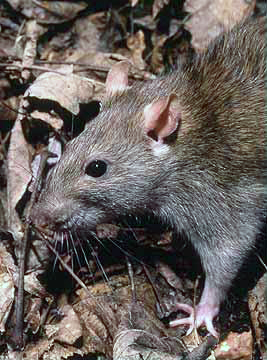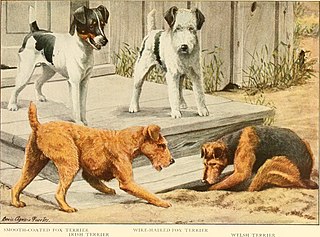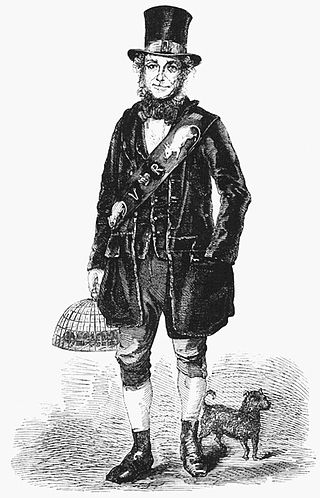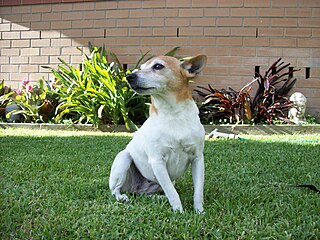Related Research Articles

Rats are various medium-sized, long-tailed rodents. Species of rats are found throughout the order Rodentia, but stereotypical rats are found in the genus Rattus. Other rat genera include Neotoma, Bandicota and Dipodomys.

The fancy rat is the domesticated form of Rattus norvegicus, the brown rat, and the most common species of rat kept as a pet. The name fancy rat derives from the use of the adjective fancy for a hobby, also seen in "animal fancy", a hobby involving the appreciation, promotion, or breeding of pet or domestic animals. The offspring of wild-caught specimens, having become docile after having been bred for many generations, fall under the fancy type.

Terrier is a type of dog originally bred to hunt vermin. A terrier is a dog of any one of many breeds or landraces of the terrier type, which are typically small, wiry, game, and fearless. There are five different groups of terrier, with each group having different shapes and sizes.

The Amazing Maurice and His Educated Rodents is a children's fantasy novel by British writer Terry Pratchett, published by Doubleday in 2001. It is the twenty-eighth novel in the Discworld series and the first written for children. The story is a new take on the German fairy tale about the Pied Piper of Hamelin and a parody of the folk tale genre.

Jack Black was a rat-catcher and mole destroyer from Battersea, England during the middle of the 19th century. At the time, England was ravaged by a massive population of rats that disrupted crops and spread disease, and Black's rat killing abilities made him a minor celebrity and Queen Victoria's official rat-catcher. Though he has been called the rat's "most notorious enemy," he did not kill all rats. Black bred unusually colored rats and sold them as pets, playing a large role in domesticating the animal. He had a flamboyant appearance, typically donning a self-made "uniform" of a green topcoat, scarlet waistcoat, and breeches, with a huge leather sash inset with cast-iron rats.

The Miniature Fox Terrier is a small, fine, lightweight working terrier developed as a hunting dog and vermin router. It is known colloquially in its native Australia as the “Mini Foxie”.

The Muridae, or murids, are either the largest or second-largest family of rodents and of mammals, containing approximately 870 species, including many species of mice, rats, and gerbils found naturally throughout Eurasia, Africa, and Australia.

A rat-catcher is a person who kills or captures rats as a professional form of pest control. Keeping the rat population under control was practiced in Europe to prevent the spread of diseases, most notoriously the Black Death, and to prevent damage to food supplies. In modern developed countries, such a professional is otherwise known as a pest control operative or pest exterminator.

The Teddy Roosevelt Terrier is a small to medium-sized American hunting terrier. It is lower-set, with shorter legs, and is more muscular with heavier bone density than the related American Rat Terrier. Much diversity exists in the history of the Teddy Roosevelt Terrier breed, and it shares a common early history with the American Rat Terrier, Fox Paulistinha, and Tenterfield Terrier. The Rat Terrier's background is said to stem from the terriers or other dogs that were brought over by early English and other working-class immigrants. Since the breed was a farm, hunting, and utility dog, little to no planned breeding was used other than breeding dogs with agreeable traits to each other to produce the desired work ethic in the dog. The Feist (dog), Bull Terrier, Smooth Fox Terrier, Manchester Terrier, Whippet, Italian Greyhound, the now extinct English White Terrier, Turnspit Dog, and Wry-legged Terrier all share in the Teddy Roosevelt Terrier's ancestry. These early ratting terriers were then most likely bred to the Beagle or Beagle crossbred dogs and other dogs. Maximizing the influences from these various breeds provides the modern Teddy Roosevelt Terrier with a keen sense of awareness and prey drive, an acute sense of smell, and a very high intellect. Although they tend to be aloof with strangers, they are devoted companion dogs with a strong desire to please and be near their owners at all times.

An earthdog test or earthdog trial tests the working ability and instinct of the small, often short-legged terriers or Dachshunds. These dogs were bred to hunt vermin and other quarry which lived in underground dens. Earthdog den tests involve human-made tunnels that the dogs must navigate, while scenting a rat, "the quarry". The dog must follow the scent to the quarry and then "work" the quarry. Depending on the sanctioning organization, "working" means barking, scratching, staring, pawing, digging; any active behavior. The quarry is protected at all times by wooden bars across the end of the tunnel. The hunting encounter is controlled, and neither the dog nor the quarry are endangered by the activity.
Varmint hunting or varminting is the practice of hunting vermin — generally small/medium-sized wild mammals or birds — as a means of pest control, rather than as games for food or trophy. The targeted animals are culled because they are considered economically harmful pests to agricultural crops, livestocks or properties; pathogen-carrying hosts/vectors that transmit cross-species/zoonotic diseases; or for population control as a mean of protecting other vulnerable species and ecosystems.

Rat-baiting is a blood sport that involves releasing captured rats in an enclosed space with spectators betting on how long a dog, usually a terrier often referred to as a ratter, takes to kill the rats. Often, two dogs competed, with the winner receiving a cash prize. It is now illegal in most countries.

The Ratonero Bodeguero Andaluz is a Spanish breed of dog of the terrier type. Its name reflects its main occupation: hunting rats and mice hidden between barrels in the wineries of Andalusia in Spain. It was recognised as an indigenous Spanish breed in 2000 by the Spanish Ministry of Agriculture and by the Spanish Kennel Club, the Real Sociedad Canina de España.

A feist is a small hunting dog. This group descended from the terriers brought over to the United States by British miners and other immigrants. These terriers probably included crosses between the Smooth Fox Terrier, the Manchester Terrier, and the now-extinct English White Terrier. These dogs were used as ratters, and gambling on their prowess in killing rats was a favorite hobby of their owners. Some of these dogs have been crossed with Greyhounds, Whippets or Italian Greyhounds, and Beagles or other hounds — extending the family to include a larger variety of purpose than the original ratter, or Rat Terrier.

The Gambian pouched rat, also commonly known as the African giant pouched rat, is a species of nocturnal pouched rat of the giant pouched rat genus Cricetomys, in the family Nesomyidae. It is among the largest muroids in the world, growing to about 0.9 m (3 ft) long, including the tail, which makes up half of its total length. It is widespread in sub-Saharan Africa, ranging from Senegal to Kenya and from Angola to Mozambique from sea level to 2,000 m (6,600 ft).

Rodents are mammals of the order Rodentia, which are characterized by a single pair of continuously growing incisors in each of the upper and lower jaws. About 40% of all mammal species are rodents. They are native to all major land masses except for Antarctica, and several oceanic islands, though they have subsequently been introduced to most of these land masses by human activity.

Rats in New York City are widespread, as they are in many densely populated areas. They are considered a cultural symbol of the city. For a long time, the number of rats in New York City was unknown, and a common urban legend declared there were up to five times as many rats as people. However, a 2023 study estimates that there are approximately 3 million rats in New York, which is close to a third of New York's human population.

The Ratonero Valenciano, also known as the Gos Rater Valencià, is a breed of dog that originates in Spain. Recognised by the Real Sociedad Canina de España in 2004, it has had recent success with a member of the breed winning the Spanish National Dog Show in 2011. It is a traditionally docked breed. In 2022, the FCI finally recognised the breed, naming it rather "Terrier" than "Ratter".
Ratcatcher is informal attire worn when fox hunting and consists primarily of a tweed jacket with tan breeches. Other specific items of clothing, forming part of the "uniform", might be prescribed by individual hunting clubs.
A ratter is any dog used for catching and killing rats and similar vermin. Specialized rat-catching breeds are found in many countries. A typical ratter is small to medium-sized and has a short and smooth coat, however a wide range of dog breeds and landraces may be used. The use of ratting dogs is widely considered to be the most environmentally friendly, humane and efficient methods of exterminating rodents. Ratting dogs are considered more efficient than domestic cats.
References
- ↑ Bitsky, Leah (March 23, 2017), "Meet the fearless dogs solving NYC's rat problem", New York Post , archived from the original on November 14, 2017, retrieved December 20, 2017
- ↑ Kilgannon, Corey (November 21, 2013), "In Manhattan Alleys, Dogs on Rat Hunts Find Bags of Fun", The New York Times , archived from the original on November 1, 2017, retrieved December 20, 2017
- ↑ Newman, Will (December 9, 2014), Spending a Night with New York's Finest Rat-Hunting Club, Vice.com, archived from the original on October 3, 2017, retrieved October 2, 2017
- ↑ Harris, Emma Patti (August 11, 2014), "The Rat Catchers of New York", The Dark Room (Photo essay), The Baltimore Sun, archived from the original on December 27, 2014, retrieved October 2, 2017
- ↑ Kilgannon, Corey (December 7, 2013), "Brits can keep their foxes; New Yorkers do rat hunts", The Seattle Times, archived from the original on October 3, 2017, retrieved October 2, 2017
- ↑ Moxley, Mitch (2013), The Rat Hunters of New York, Roads & Kingdoms, archived from the original on September 10, 2017, retrieved October 2, 2017
- ↑ Strusiewicz, Cezary Jan; Reynolds, Richard (January 13, 2016), "6 Creepy Realities Of The (Shockingly Real) Rat Hunting Game", Cracked , archived from the original on October 3, 2017, retrieved October 2, 2017
- ↑ Davenport, Emily (August 28, 2017), 'Vigilante dogs' honored in Ozone Park for literally sinking their teeth into the local rodent population, Qns.com, archived from the original on October 3, 2017, retrieved October 2, 2017
- ↑ Honan, Katie (August 29, 2017), 'Vigilante' Dogs Sniff Out Rats Running Wild in Queens, DNAinfo, archived from the original on October 3, 2017